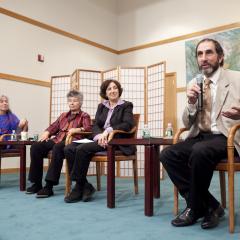John Berthrong Explores Creativity East and West
In this essay, written as an original contribution to the Ikeda Center’s 2009 investigation into the subject of “a new humanism,” Professor John Berthrong of Boston University reveals how creativity has functioned in human thought and action. Placing the concept in historical and cross-cultural contexts (comparing specifically with the classical Chinese notion of “generativity without ceasing”), the author explores both the limitations and the potential of creativity as a force for human and global flourishing.
A Brief History
It may come as something of a surprise but creativity is actually a relatively new word. The most recent edition of the Oxford English Dictionary, the most comprehensive of all English dictionaries, notes that the first usage of creativity can be dated to 1875. In an earlier edition of the OED I remember seeing a single reference to the word in the seventeenth century. In fact, it was probably the influence of the great Anglo-American philosopher Alfred North Whitehead that put “creativity” on the linguistic map when he used the word in his Religion in the Making (1926). The rest, as they say, is history. Or is it?
Creativity is the action of being creative, of finding fresh achievements, of focused curiosity, and exploring—just to mention a few cognates, terms, and concepts. In fact, when you explore the use of the term creativity these days in a cursory fashion it is not surprising that many models for the definition of creativity are to be found in the fields of psychology, cognitive science, and systems theory. These are the social sciences and cognitive academic disciplines that chart and examine the flow of the creative energies of human beings and attempt to explain the results of creative human actions in the astounding contemporary achievements manifested in the arts, sciences, and technology. Older occult traditions in the East and West even expand the range of creativity to include elementals, spirits, angels, and demons. The Devil, as Milton taught, was a bit too clever by a turn and was damned for his diabolical creativity and stubborn will in trying to fathom the supernal wisdom and will of the divine mind-heart.
The Wikipedia article on creativity argues that neither the Greeks nor the Romans had a term that corresponds neatly with our post-1920s understanding of creativity. Rather, the article argues that we only come close to creativity after the rise of theological reasoning in Christianity by means of the Latin notion of creatio wherein God wills the world into existence, actually producing a cosmos out of nothing. The emphasis on God’s willful act of creation was deemed even superior to God’s wisdom by the late medieval period. What can be more potent, more creative, than the act of willing a world into existence? Mere knowing pales in comparison.
Novelty and Folly
The story, of course, begins to change with the Renaissance and the Age of Enlightenment. The power of human action was reaffirmed and the potency of individual imagination and artistic, philosophical, and scientific innovation became deeply appreciated and encouraged. There might have been a classical golden age represented by the best of Greek and Roman civilization, but this did not mean that modern people could not also think and act in novel, creative ways. The story continues to unfold down to today when creativity has become a buzzword; it is deemed so much better to be novel and creative than merely to imitate what has gone before. So there is even the pretense in the academic world that every doctoral dissertation is what Whitehead called a creative advance into novelty, the expression of an insight never seen before on land, sea, or even in the heavens above.
But sometimes there is a nagging doubt about the worship of such individualistic creativity. It seems to work fine when a culture perceives itself on the rise to global fame and fortune but we get a little skeptical when things don’t go as planned. Certainly, creativity can have unintended negative social consequences. For instance, in a turn of events that bring Milton’s Devil back to mind, we are all learning that unrestrained and unregulated clever “creativity” in financial markets, the invention of sophisticated fiscal instruments that defy prudence even if they are perfectly legal, manifests more folly than sound economic policy. Can excessive creativity in the global market lead to disaster for countless millions of unsuspecting citizens of the global village? The answer appears to be yes: we can definitely create disaster and pain out of certain forms of creativity.
The Classical Chinese Perspective
Does this bump in the road of human ingenuity mean that we must abandon “creativity”? I believe this would be a mistake. However, we must learn to think about creativity in a different way. In order to do so I suggest that we look at creativity from the perspective of classical Chinese philosophical and spiritual examples. This enduring worldview, drawn from the great teachings of Confucianism, Daoism, and Buddhism, holds that the very nature of the cosmos resides in the ceaseless transformation and change of the myriad objects and events that constitute the enduring flux of the cosmos. Change lies at the heart of the world. Because Confucianism is the elder sibling in China I will focus our attention on how the Confucians framed the issue of creativity. While Daoists and Buddhists have unique understandings of the creative act, there is a shared sensibility in all of these great schools about the creative nature of the cosmos.
Because things lack any essential, permanent, immortal substance, or soul, the nature of things is to come together and fall apart.
John Berthrong
Take Buddhism as an example. One of the key teachings of Buddhism is the fact of impermanence. Because things lack any essential, permanent, immortal substance, or soul, the nature of things is to come together and fall apart. Other major teachings such as the law of karma, that if this, then that, or if such an action then such a reaction, help to explain how the mundane world unfolds in front of our sense organs. Yet none of this sense world will last forever. In fact, everything that exists is a compound object that will finally fall apart. Hence the very nature of mundane reality is transformation and in that sense, the creativity of the arising and extinction of the myriad things, as Chinese Buddhists would say. A key insight of this worldview is that the coming to be and the decline and extinction of the objects and events of the cosmos constitutes the creative interdependent nature of the Dao, the matrix of everything that was, is, and may become.
This kind of Buddhist reflection resonates with some of the oldest of Chinese philosophical and spiritual speculations. The foundation of the insight about process or transformation is found in the Yijing, purportedly the oldest of the Chinese classics. While revered by the Confucian tradition, the Yijing has been studied with equal respect by countless generations of Daoists and Buddhists as well. Both traditional and contemporary Confucian scholars have pointed out that the Yijing teaches that the very nature of the Dao (The Way, the Path, the Course) is defined as shengsheng buxi (generativity without ceasing). The reduplicative shengsheng means birth upon birth, the constant generation of the myriad things. Dao is a beginningless and unending process. One of the most famous of modern New Confucian philosophers, Mou Zongsan (1909-1995), defined this in modern terms as “creativity itself.” Mou, as a justly famous scholar of the Chinese classical philosophical traditions, had also studied Whitehead and believed that Whitehead’s novel term creativity was a fine English correlate for the primordial teaching of the generativity of the Dao in the Yijing.
Toward Human and Global Flourishing
From the Chinese perspective we notice two things. First, the world is in a constant state of flux, transformation, and process. Second, this unending generative process is understood as creative in the sense that new things and events constantly emerge and return to the supernal matrix of the Dao. But it is likewise important to remember that this is not the modern doctrine of progressivism that maintains that everything that is new is essentially good when compared to anything old. From the Chinese perspective, things and events can go wrong, become deformed, evil, or destructive of the common good. Just as in Buddhism, everything in the Confucian cosmos is related to everything else. And just as the Buddhist teaching of the need for wisdom and compassion, the Confucian sage commends, among the other obligatory virtues, the necessity for humaneness (ren) and discernment or wisdom (zhi).
We learn at least two things, then, from this brief tour of historical Western views of and traditional Chinese teachings about creativity that can inform our understanding of this phenomenon. First, creativity is the very nature of the Dao (The Way, Course) of the cosmos now and forever. So simply “being creative” isn’t enough in and of itself, though the Western version of creativity at its best has been enormously enriching to individuals and society. Hence human beings must find a way to be creative in a just and appropriate fashion, utilizing all the wisdom, discernment, compassion, and humaneness at our disposal. Second, persons are not isolated individuals disconnected from other humans, the animals, the plants, and the earth itself. We must test our creativity with a concern for the insight that we are parts of the vast web of creation and we have a responsibility to heaven, earth, and humanity to assist in the flourishing of all creatures, great and small. The earth is our home and we have a tremendous need now for true creativity in becoming good neighbors for all our relations in the grand green and blue biosphere.



